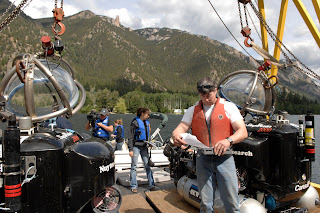 Today's blog brought to you by:
Today's blog brought to you by:Darlene Lim
Photo: Darlene sectioning microbialite at Pavilion Lake
Photo credit: Bill Taylor
A Summary of Phase II of our 2008 field season – great field science, and tired so-longs for now
With the departure of the Deepworkers from Pavilion Lake on July 3rd, came the arrival of a new crop of researchers to move the project into the second phase of field operations. From July 4-11th, the PLRP was engaged in science diving activities in Pavilion and Kelly lakes. These dives were primarily to support the PLRP geobiological investigations. During these dives, water, microbialite, sediment, and microbial mat samples were collected for a variety of analyses (geochemical, microscopic, mineralogical, molecular, organic, thin section and taxonomic). Some ground truthing of the Deepworker waypoints of interest was conducted, however given the long list of science items we had to check off, we decided to leave much of the ground truthing to another expedition next year. A subgroup of the geobiology team spent 3 days investigating ponds on the Cariboo plateau, which are viewed as geochemical book ends to our understanding of carbonate precipitating environments. Greg Druschel from the University of Vermont conducted micro-electrode analyses to help with our understanding of the sediment redox chemistry in these ponds and Pavilion Lake. As well, Alfonso Davila from NASA Ames used a portable Raman spectrometer to investigate organic signatures in the microbialites and the mats from the various lakes and ponds.
Bekah Shepard spent hours diving in 10-20 feet of water investigating the unusual mat morphologies in the shallow regions of Pavilion Lake. While scouring the lake for interesting slime, as she puts it, Bekah discovered depressions in the shallows that had the distinct odor of hydrogen sulfide (that horrid rotten egg smell), indicative of the presence of sulfate-reducing bacteria. This led to water samples and pH data being collected from these points of interest. Bekah and Harry Bohm also discovered a region of incoming groundwater in Pavilion Lake. PLRP members have been on the hunt for a recognizable input point for groundwater for years, however given the low, diffuse flow throughout most of the lake, this find has eluded us – until now. The spring was located in the shallows, and was visually and thermally apparent to divers. This will most certainly be a region we will return to in the future to sample the groundwater for limnological and isotopic analyses. With the discovery of this spring, we hope to better understand how to locate others in the lake, and to determine whether or not the groundwater is an important contributor to the development of microbialites in Pavilion Lake.
The UBC-GAVIA team conducted mapping work at Pavilion and Kelly lakes, and added to their growing data base of sonar and photographic images from these two sites. Their research, along with that of Geoff Mullins from Simon Fraser University, has been the backbone of our understanding of Pavilion Lake’s physical characteristics. The SONAR maps produced by Geoff provided high-resolution remote sensing data that was used to plan Deepworker dives throughout Pavilion Lake. Water samples and pH profiles were also collected from a series of other regional lakes and ponds as part of the PLRP’s long-term limnological monitoring program in the area.
Throughout all of these science activities, the PLRP had the privilege of hosting Bill Taylor, a high school physics teacher from California, who was embedded with the team for the duration of Phase II. His enthusiasm, humor, and energy were infectious, and I know that his students will benefit greatly from all that he learnt while in the field with us.
We had an incredible team that made the 2008 field season possible. All supported each other through long, hot days, and late, tired nights. It was amazing to watch in action, and such a privilege to be a part of. Thank you again to the Ts’kw’aylaxw First Nations people, Pavilion Lake Community, B.C. Parks Service, and in particular to Mickey and Linda Macri, and Ron and Lorna Cook, for the incredible support and encouragement. As well, thank you to the Canadian Space Agency CARN program, NASA ASTEP and Spaceward Bound programs, Nuytco Research, McMaster University and the National Geographic Society for funding our PLRP endeavors over the years.
This is our final report for the 2008 field season. Thank you to everyone who has been following our adventures – stay tuned for more to come in 2009.
DSSL
July 14, 2008


















